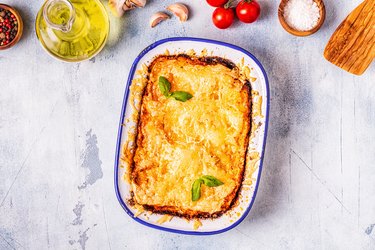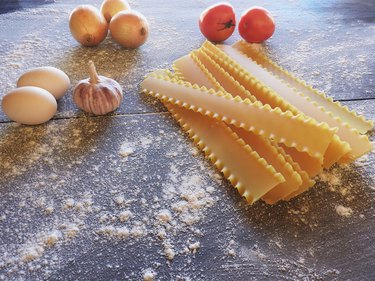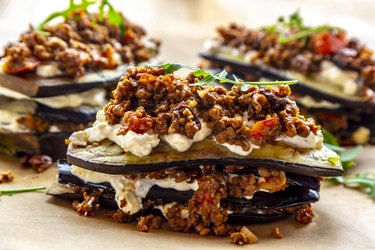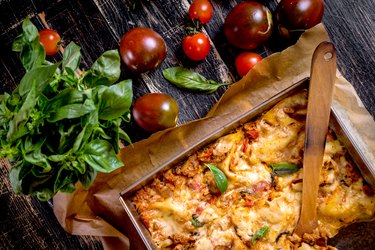
Cooking lasagna in advance will have you thanking your past self. That's because make-ahead lasagna means a comforting, cheesy and satisfying meal is in your future.
Assembling lasagna the day before you plan to serve it makes it easy to get a delicious meal on the table after a long day. You can also freeze the lasagna to serve weeks later. Make-ahead meals are a great convenience, and unless you're hosting a big group, make-ahead lasagna often leads to leftover lasagna.
Video of the Day
Video of the Day
Tip
You can assemble lasagna and cook it the next day. However, be sure to cook it within 36 hours.
Questions About Make-Ahead Lasagna
Erica Mouch, RDN, CD, of Erica Mouch Nutrition, has some helpful tips when it comes to make-ahead lasagna.
"Assembling lasagna the day before you need it is a time-saver, and it won't have a negative effect on the noodles," she says. "Uncooked lasagna can last 36 hours in the refrigerator, but if you don't plan to cook it within 12 hours, shorten the boiling time a bit when cooking the noodles. Take the lasagna out of the refrigerator an hour before baking to ensure it cooks evenly."
What about cooking the lasagna ahead of time and storing for leftovers? "Once cooked, it will keep in the refrigerator for three days. You can also freeze it after cooking to use another time. When you need it, thaw it the day before in the refrigerator before reheating," Mouch advises.
Lasagna can sometimes be either too dry, or too runny. "To prevent dryness, cover with foil during baking, but remove later to brown the cheese. If you drain the noodles well before assembling the lasagna, it can prevent the dish from being too runny: Another option is to use no-boil noodles," Mouch says.
Lasagna Meal Planning
How far in advance can you make lasagna before cooking it? When it comes to making lasagna ahead of time, Mouch says uncooked lasagna is best stored for up to 36 hours. To prevent the dish from getting soggy or watery, consider boiling the noodles for less time — so they are more al dente — or opting for no-boil noodles.
You may choose to freeze your lasagna once its cooked, which is a great option. It's safer to cool hot food quickly to prevent bacterial growth, according to the USDA. So if you make a large lasagna and plan to freeze half, divide the dish and freeze the leftovers as soon as possible. The same goes for if you plan to chill lasagna in the refrigerator: Put away the leftovers within two hours of baking the lasagna to ensure food safety.
When you prepare make-ahead lasagna to freeze, make sure you have some good storage options on hand. You'll want to cover the leftovers — either by wrapping them in airtight packaging or sealing them in storage containers, per the USDA. Doing this will prevent bacteria from creeping in and keep any other food odors in your fridge or freezer out of your perfect lasagna.
Reheating Frozen Lasagna
When you're ready to reheat your frozen lasagna, Mouch suggests allowing it to first thaw in the fridge for 24 hours. Avoid defrosting the lasagna out on the kitchen counter; if it is left out for over two hours, it may not be safe to consume.
It is also safe to reheat the lasagna straight from the freezer without thawing, per the USDA. The reheating time will take longer than it would if the food were thawed.
If you choose to reheat your lasagna in the oven, transfer the lasagna to an oven-proof container and baking it without a cover at 400 degrees Fahrenheit, per Oregon State University. An individual portion should take about an hour, whereas a large dish may take up to two hours.
No matter how you decide to reheat your lasagna, be sure it reaches as internal temperature of at least 165 F — which you can measure with a food thermometer — to know it is safe to eat.
Make-Ahead Spinach Lasagna
Need an easy lasagna recipe? The recipe below for make-ahead meatless lasagna is adapted from the University of Nebraska at Lincoln.
Spinach Lasagna
Servings: 8
Ingredients:
- 1 10-ounce box spinach, frozen
- 1 tablespoon Italian seasoning
- 2 eggs, beaten
- 1 15-ounce container ricotta cheese
- 1 6-ounce container parmesan cheese, shredded, divided
- 9 lasagna noodles, uncooked
- 1 3-pound jar spaghetti sauce
- 1 6-ounce package Mozzarella cheese, grated, divided
- 1/2 cup water
Directions:
- Preheat oven to 350 degrees Fahrenheit. Coat a 9-inch by 13-inch baking pan with oil.
- Thaw the spinach and drain the liquid.
- In a bowl, mix together spinach, Italian seasoning, eggs, ricotta cheese and 2 tablespoons of parmesan cheese.
- Put 3/4 cup of spaghetti sauce in the bottom of the pan. Top with three uncooked noodles. Next, cover noodles with 1/3 of spinach mixture and sprinkle with mozzarella cheese. Top this layer with 3/4 cup spaghetti sauce. Layer with noodles, spinach mixture, mozzarella cheese and sauce two additional times.
- Put the remaining three noodles and spaghetti sauce on top. Remove all the sauce from the jar by putting in the 1/2 cup water and shaking it.
- Spread the remaining mozzarella cheese and parmesan cheese on top. Cover the pan with foil.
- Put the lasagna in the refrigerator to cook the next day, or cook it immediately for 60 to 75 minutes until cheese is lightly browned. The lasagna cook time may vary slightly depending on your oven. Cook uncovered for the last 10 minutes.
How to Make Your Own Healthy Lasagna
Lasagnas with meat can be made of ground beef, ground turkey or a combination of beef and Italian sausage. Meatless lasagnas often feature spinach, but sometimes they include other vegetables, like mushrooms, as well.
Red meat is associated with a higher cancer risk, according to the American Institute for Cancer Research. For this reason, if you make lasagna often, opt for recipes that feature either ground poultry or vegetables. An additional advantage of lasagnas made solely of vegetables is that they're very low in fat.
Another way to make a healthier lasagna is to use whole grain pasta rather than pasta made with white flour. Whole grains contain fiber, which is linked to several health benefits, like promoting heart health, healthy weight and improved digestion, according to the Mayo Clinic.
To get an idea of what a very nutritious lasagna recipe looks like, the American Heart Association has an excellent one. It's low in salt, and is made with extra virgin olive oil, whole grain noodles and several vegetables, including spinach, kale, squash and cannellini beans.
- Erica Mouch Nutrition
- American Institute for Cancer Research: "Red and Processed Meats"
- American Heart Association: "Lasagna"
- University of Nebraska at Lincoln: "Make Ahead Meals"
- Mayo Clinic: "Dietary Fiber: Essential for a Healthy Diet"
- USDA: "Leftovers and Food Safety"
- Oregon State University: "Reheating Convenience Foods That You've Prepared At Home"


